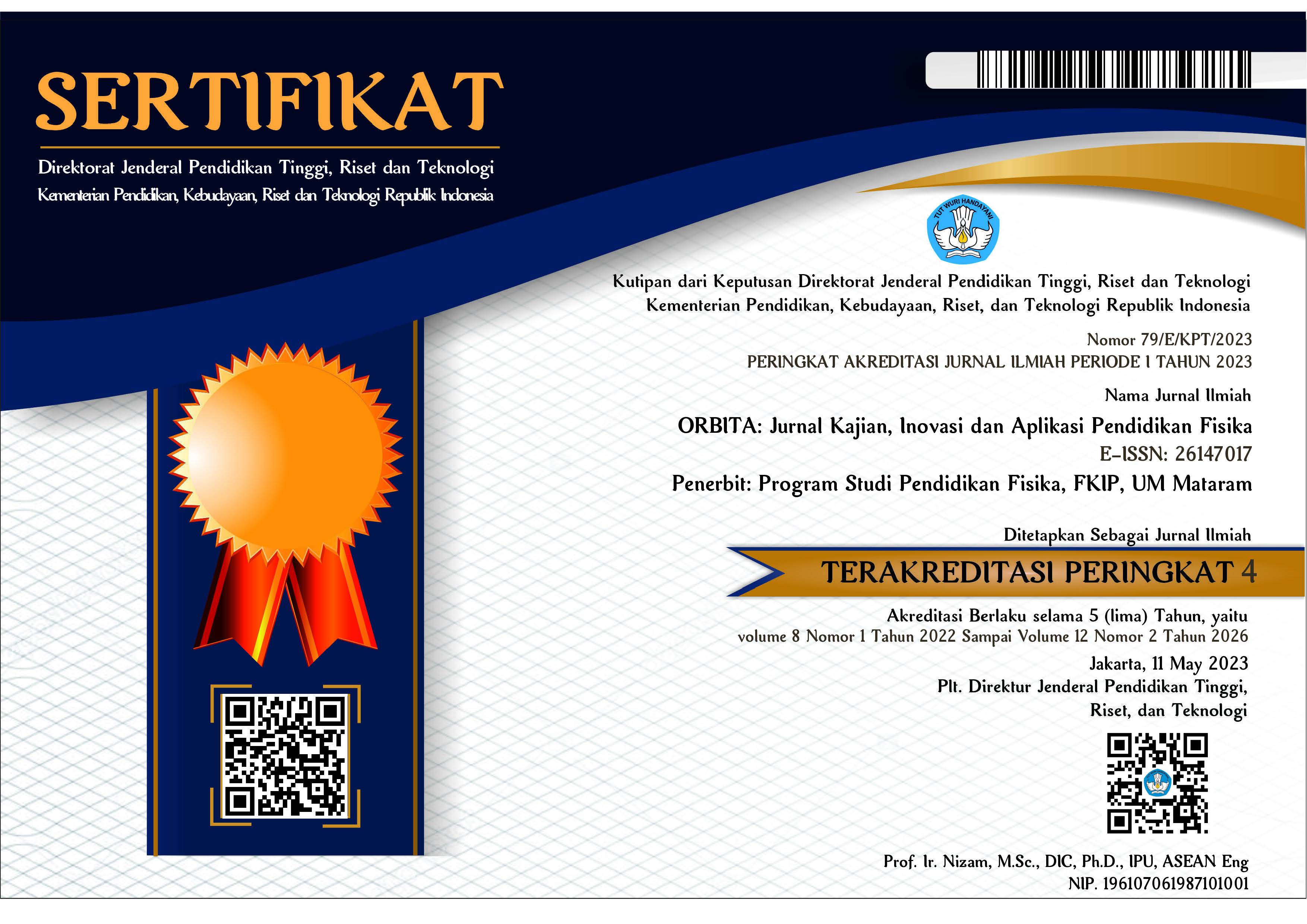PENGUJIAN KEMAMPUAN MENGINTERPRETASIKAN GRAFIK KINEMATIKA CALON GURU FISIKA: THE POLYTOMOUS RASCH ANALYSIS
Abstract
ABSTRAK
Kemampuan interpretasi grafik merupakan kemampuan yang sangat penting dan kunci utama dalam memahami materi kinematika dan materi fisika lanjutan. Namun kemampuan interpretasi grafik materi kinematika mahasiswa calon guru masih rendah. Tujuan penelitian ini menguji kemampuan membaca dan menginterpretasikan grafik kinematika calon guru dengan analisis polytomous rasch model. Instrumen terdiri dari empat soal uraian menyajikan grafik kinematika. Tes diberikan ke 20 mahasiswa calon guru, terdiri dari 14 perempuan dan 6 laki-laki. Metode yang digunakan survei deskriptif kuantitatif dengan analisis menggunakan rasch model dengan data politomi. Hasil yang diperoleh nilai reliabilitas 0,58 kategori lemah, tingkat kesukaran untuk 3 soal dalam kategori sukar dan satu soal kategori mudah, daya pembeda berkategori sangat baik untuk seluruh soal. Kemampuan membaca dan menginterpretasikan grafik kinematika secara keseluruhan cukup baik. Kesimpulannya instrumen dan analisis yang digunakan dapat menguji kemampuan menginterpretasikan grafik kinematika calon guru.
Kata kunci: interpretasi; grafik, kinematika; polytomous rasch.
ABSTRACT
The ability to interpret graphs is a very important ability and the main key in understanding kinematics and advanced physics materials. However, the ability to interpret graphs of prospective teachers is still low. The purpose of this study is to test the ability to read and interpret the kinematic graphs of prospective teachers using polytomous rasch model analysis. The instrument consists of four essay questions presenting a kinematic graph. The test was given to 20 prospective teachers, consisting of 14 females and 6 males. The method used is quantitative descriptive survey with analysis using the rasch model with polytomous data. The results obtained were the reliability value of 0.58 in the weak category, the level of difficulty for 3 questions in the difficult category and one question in the easy category, the distinguishing power was very good for all the questions. The overall ability to read and interpret kinematics graphs is quite good. In conclusion, the instruments and analysis used can test the ability to interpret the prospective teacher's kinematics graph.
Keywords: interpretation; graph; kinematics; polytomous.
Keywords
Full Text:
PDFReferences
Amin, B. D., Sahib, E. P., Harianto, Y. I., Patandean, A. J., Herman, & Sujiono, E. H. (2020). The interpreting ability on science kinematics graphs of senior high school students in South Sulawesi, Indonesia. Jurnal Pendidikan IPA Indonesia. https://doi.org/10.15294/jpii.v9i2.23349
Bektasli, B. (2006). The Relationships Between Spatial Ability, Logical Thinking, Mathematics Performance And Kinematics Graph Interpretation Skills Of 12th Grade Physics Students. Interpretation A Journal of Bible And Theology.
Bektasli, B. (2012). The Relationships between Logical Thinking, Gender, and Kinematics Graph Interpretation Skills. Eurasian Journal of Educational Research, 48, 1–19.
Bunawan, W., Setiawan, A., Rusli, A., & . N. (2015). Penilaian Pemahaman Representasi Grafik Materi Optika Geometri Menggunakan Tes Diagnostik. Jurnal Cakrawala Pendidikan, 2(2), 257–267. https://doi.org/10.21831/cp.v2i2.4830
Karamustafaoğlu, S. (2011). Improving the Science Process Skills Ability of Science Student Teachers Using I Diagrams. Eurasian J. Phys. Chem. Educ, 3(1), 26–38. Retrieved from http://www.eurasianjournals.com/index.php/ejpce
Kekule, M. (2014). Students’ approaches when dealing with kinematics graphs explored by eye-tracking research method. Proceedings of the Frontiers in Mathematics and Science Education Research Conference, (May), 108–117.
Kukliansky, I. (2016). Student’s Conceptions in Statistical Graph’s Interpretation. International Journal of Higher Education, 5(4). https://doi.org/10.5430/ijhe.v5n4p262
Manurung, S. R., Mihardi, S., Rustaman, N. Y., & Siregar, N. (2018). Improvement of Graph Interpretation Ability Using Hypertext-Assisted Kinematic Learning and Formal Thinking Ability. Jurnal Pendidikan Fisika Indonesia, 14(1), 1–6. https://doi.org/10.15294/jpfi.v14i1.9444
Maries, A., & Singh, C. (2013). Exploring one aspect of pedagogical content knowledge of teaching assistants using the test of understanding graphs in kinematics. Physical Review Special Topics - Physics Education Research, 9(2), 1–14. https://doi.org/10.1103/PhysRevSTPER.9.020120
Nugraha, A., Saehana, S., & Darsikin. (2016). Kesulitan Siswa Dalam Menyelesaikan Permasalahan Grafik Kinematika. Jurnal Inovasi Dan Pembelajaran Fisika, 77–88.
Park, T., Liu, M. Y., Wang, T. C., & Zhu, J. Y. (2019). Semantic image synthesis with spatially-adaptive normalization. In Proceedings of the IEEE Conference on Computer Vision and Pattern Recognition (pp. 2337–2346). Retrieved from http://www.ghbook.ir/index.php?name=مجموعه مقالات دومین هم اندیشی سراسری رسانه تلویزیون و سکولاریسم&option=com_dbook&task=readonline&book_id=13629&page=108&chkhashk=03C706812F&Itemid=218〈=fa&tmpl=component
Parmalo, Y., Djudin, T., & Oktavianty, E. (2016). Deskripsi Kemampuan Menafsirkan Grafik Kinematika Siswa Kelas X SMA Negeri 3 Sungai Kakap. Jurnal Pendidikan Dan Pembelajaran Khatulistiwa, 5(7), 11–40.
Petrova, H. G. (2016). Developing Students , Graphic Skills In Physics Education At Secondary School. Journal of Research and Method in Education, 6(5), 123–126. https://doi.org/10.9790/7388-060501123126
Pujianto, A. (2013). Analisis Konsepsi Siswa Pada Konsep Kinematika Gerak Lurus. JPFT (Jurnal Pendidikan Fisika Tadulako Online), 1(1), 16–21. https://doi.org/10.22487/j25805924.2013.v1.i1.2370
Rahmawati, L. F., Ali, M., & Kendek, Y. (2014). Perbedaan Hasil Belajar Fisika Antara Model Pembelajaran Sains Teknologi Masyarakat Dan Model Pembelajaran Direct Instruction Pada Siswa Kelas X Sma Negeri 1 Palu. JPFT (Jurnal Pendidikan Fisika Tadulako Online), 1(1), 48–54. https://doi.org/10.22487/j25805924.2013.v1.i1.2473
Redding, C. W. (2014). Effect of Predicting Motion on Student Understanding of Kinematic Graphs. LSU Master’s Theses, (August).
Salameh, M., & Aldhamit, Y. (2014). The Effect of Computer Simulation on Al-Hussein Bin Talal Unıversıty S tudent ’ s Understanding of Electricity and Magnetism Concepts and their Attitudes towared Physics Learning. International Journal of Educational Research and Technology, 5(March), 54–60.
Setyono, A., Nugroho, S. E., & Yulianti, I. (2016). Analisis Kesulitan Siswa Dalam Memecahkan Masalah Fisika Berbentuk Grafik. UPEJ Unnes Physics Education Journal, 5(3), 32–39. https://doi.org/10.15294/upej.v5i3.13729
Sharma, S. (2013). Assessıng Students ’ Understandıng of Tables and Graphs : Implıcatıons for Teachıng and Research. International Journal of Educational Research and Technology, 4(December), 51–70.
Subali, B., Rusdiana, D., Firman, H., & Kaniawati, I. (2015). Analisis Kemampuan Interpretasi Grafik Kinematika pada Mahasiswa Calon Guru Fisika. Prosiding Simposium Nasional
Inovasi Dan Pembelajaran Sains 2015 (SNIPS 2015), 2015(Snips), 269–272.
Sumintono, B. (2015). Aplikasi Pemodelan Rasch pada Assessment Pendidikan. Trim Komunikata.
Uzun, M. S., Sezen, N., & Bulbul, A. (2012). Investigating Student’s Abilities Related to Graphing Skill. Procedia - Social and Behavioral Sciences, 46(1990), 2942–2946. https://doi.org/10.1016/j.sbspro.2012.05.594
Vaara, R. L., & Sasaki, D. G. G. (2019). Teaching kinematic graphs in an undergraduate course using an active methodology mediated by video analysis. Lumat, 7(1), 1–26. https://doi.org/10.31129/LUMAT.7.1.374
Yustiandi, & Saepuzaman, D. (2017). Profil Kemampuan Interpretasi Grafik Kinematika Siswa SMA Kelas X. Gravity: Jurnal Ilmiah Penelitian Dan Pembelajaran Fisika, 3(1), 30–39.
Zavala, G., Tejeda, S., Barniol, P., & Beichner, R. J. (2017). Modifying the test of understanding graphs in kinematics. Physical Review Physics Education Research, 13(2), 1–16. https://doi.org/10.1103/PhysRevPhysEducRes.13.020111
DOI: https://doi.org/10.31764/orbita.v6i2.3264
Refbacks
- There are currently no refbacks.

This work is licensed under a Creative Commons Attribution-ShareAlike 4.0 International License.
______________________________________________________
ORBITA: Jurnal Pendidikan dan Ilmu Fisika
p-ISSN 2460-9587 || e-ISSN 2614-7017
This work is licensed under a Creative Commons Attribution-ShareAlike 4.0 International License.
EDITORIAL OFFICE:


























